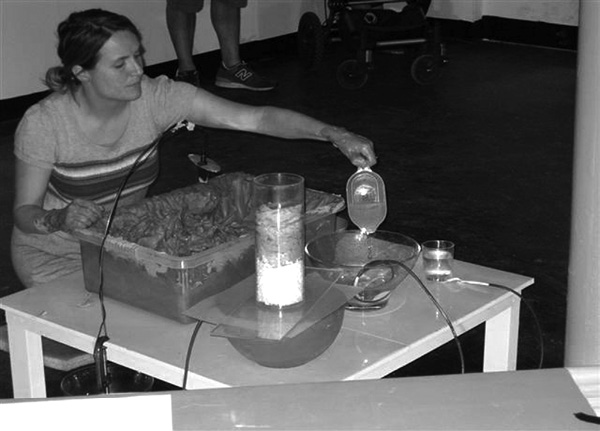
A LIVE VISUALIZATION OF POSSIBLE RELATIONSHIPS WITHIN A ROOM, MOVING MOMENT BY MOMENT
first performed on April 5, 2012
Chelsea College of Art & Design, London, UK
performed three times in 2012
RITA EVANS
London, UK
171329845r171329845i171329845t171329845a171329845m171329845a171329845r171329845i171329845n171329845a171329845e171329845v171329845a171329845n171329845s171329845@171329845g171329845m171329845a171329845i171329845l171329845.171329845c171329845o171329845m
ritaevans.com
A LIVE VISUALIZATION OF POSSIBLE RELATIONSHIPS WITHIN A ROOM, MOVING MOMENT BY MOMENT
RITA EVANS
A LIVE VISUALIZATION OF POSSIBLE RELAtIONSHIPS WITHIN A ROOM, MOVING MOMENT BY MOMENT
This work is about the values of group work and how learning through improvisation produces sensitivity to the immediate environment. Its form is a structure designed to enable this to happen using groups of participants who work together to form a live-learning situation. I am interested in the values of liveness, improvisation and group work. My influences include the political outlook of the artists involved in the Filmaktion movement as well as Joseph Beuys’ concept of social sculpture.
The performance involves three tables of materials that are categorized according to archetypal forms:
1) soft “natural” materials (clay, pulps of fibers and water);
2) machine-made materials (glass and metals, including nails and pigments);
3) domestic materials (such as silver foil, bubble wrap and baking paper).
All of these are amplified using embedded microphones and hydrophones and are therefore playable by touch and manipulation. The audience is able to walk through the room and encounter each table and player, which are spread out, each table an island. The participants at a given performance time manipulate the materials, and at first they work out how to create sound. They then eventually begin to improvise with the material to create something cohesive as a group. The sounds that are produced simultaneously affect a digital projection above the players, which floods them in an ever-changing colored light. Through a personal relationship with the materials provided by the participants, their touch and sensitivity to each other and the projection, they produce moments of group understanding of that space and time.
“An event or a thing at a point in space cannot be understood by appeal to what exists only at that point. It depends upon everything else going on around it (much as all those who enter a room to discuss bring with them a vast array of experiential data accumulated from the world). A wide variety of disparate influences swirling over space in the past, present and future concentrate and congeal at a certain point (e.g. within a conference room) to define the nature of that point. …”—David Harvey, “Space as a Key Word,” in Spaces of Global Capitalism, p 124.